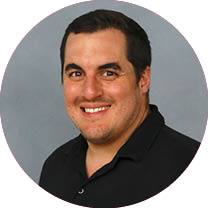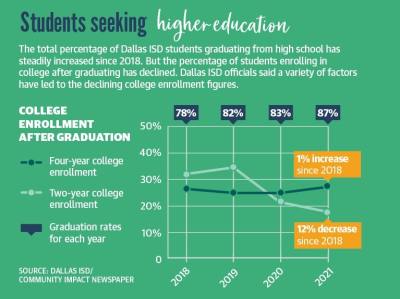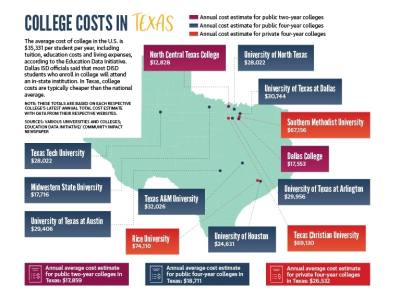The number of DISD high school graduates immediately seeking higher education has declined in recent years with a significant drop in students seeking attendance at two-year or community colleges. But the total number of students heading to four-year colleges and universities is going up, according to a presentation during the May 12 board of trustees meeting.
From the classes of 2018-2021, the percentage of DISD graduates who enrolled into college immediately after high school slid from 58% to 46%, a presentation from district staff showed. The sharpest drop between those years was from the classes of 2019 to 2020. The number of students heading to college dropped by 11 percentage points in those years. Staff partially attributed that trend to the COVID-19 pandemic.
“Our four-year college enrollment has gone up, which is a very positive trend,” said Brian Lusk, DISD chief of strategic initiatives. “But the two-year [school] enrollment went down a little bit this year.”
A total of 28% of students in the class of 2021 enrolled into a four-year school, according to the presentation. That is up from 25% of the class of 2020.
Lusk said the district’s goal for the 2024-25 school year is to have 67% of all graduating students enrolled in two-year or four-year colleges. He said it is a reachable goal for the district if they can provide students with the right resources.
“Whatever [students] need to get from Dallas ISD to their next destination, we can help them,” Lusk said. “We have seen a pattern where students don’t quite get to where they are supposed to go because they haven’t had the support along the way.”
DISD officials reported an ongoing decline in enrollment to two-year schools, dropping from 31% in 2018 to 19% in 2021. Lusk said a big factor to consider when looking at that decline is the rising number of associate degrees earned by students while attending DISD schools.
Earning college credits
The Pathways in Technology and Early College Program, or P-Tech, is a DISD initiative that officially began accepting students three years ago. The program allows a number of incoming ninth grade students to apply and choose a career pathway that could earn them up to 60 college credit hours, or the equivalent of an associate’s degree, by the time they graduate.
“We have seen phenomenal success with that program,” Lusk said. “We are not going to say that’s the sole factor [causing] two-year college enrollments to go down, but we know that is a contributing factor. Last year, we had 900 of our seniors graduate with an associate degree.”
The program is offered completely free of charge through the district. According to district data, 10% of DISD students graduated high school in 2021 with an associate degree through the P-Tech program.
“The work that has happened in the last three years ... has been tremendous and monumental to more of our students taking on [college pathways] ultimately with the goal of achieving a credential that will lead them to a living-wage job,” said former DISD trustee Karla Garcia during her last meeting as a board member in May. “That is huge and instrumental to the success of our neighborhoods and our city.”
College advising
An update to the district’s college and career advising program is underway to address declining college enrollments, according to staff. The district’s website states that the program’s goal is to establish and support DISD’s high school students while fostering a college and career-going culture.
•DISD’s board of trustees approved an $11 million increase to the program’s budget during the May 12 meeting in a bid to expand services and hire more faculty. Lusk said the district will seek to provide more college and career advisers to students in high schools by next fall. He said goals of the district include lowering the ratio of students assigned to each college advisor while starting the process of advising more students for college by grades nine and 10.
“We wanted to streamline our career and college readiness options so students are making the best-fit options for them as early as possible. We really wanted to create this seamless [college] pathway,” said Usamah Rodgers, DISD’s former deputy chief of strategic initiatives, during the May 12 meeting.
Rodgers was named DeSoto ISD’s new superintendent in May.
Another focus of the program moving forward will be to address “summer melt,” which district officials described as college plans falling through during the months following high school graduation. Advisors will ensure “all the pieces” are in place ahead of college, such as ensuring all college admissions documents and financial aid forms are filled out while staying in touch with students during the summer following graduation, Lusk said.
DISD data shows the ratio of students per college advisor across the district is 400 to 1 in grades nine and 10, and 200 to 1 in grades 11 and 12. Those figures do not account for the 300-plus counselors the district employs across each of its 240 schools.
“We want every student to know their advisors,” Lusk said. “Whether helping students apply to college, complete financial aid or look for scholarships, we know that our advisors have to spend more time with students, which means they’ll need more people to do that.”







